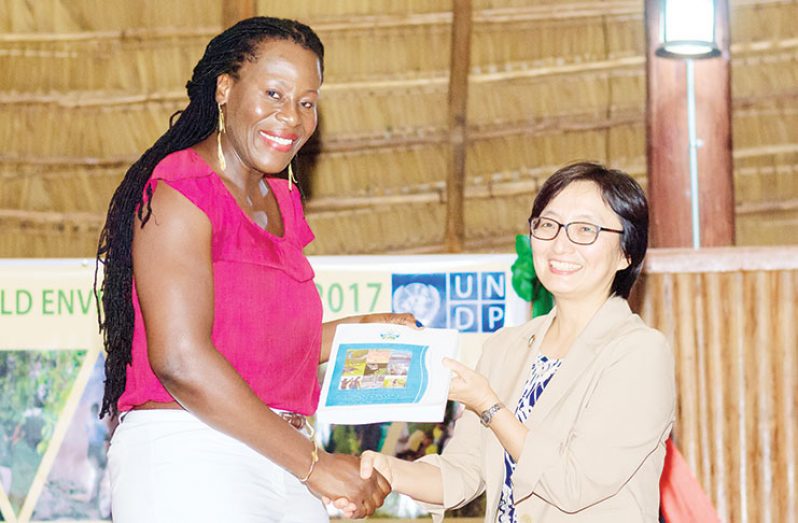-despite increased adaptation efforts by govt
THE 2016 State of the Environment Report (Guyana) has warned that a climate uncertain future looms for Guyana, particularly for the climate sensitive sectors which this country’s economy relies heavily on.
The report, which was released on Monday was developed by the government with funding from the United National Development Programme (UNDP). One of the findings was that sea level rise and saline intrusion could affect crop and livestock production in the agriculture sector; contaminate fresh-water supplies; exert additional stress on sea defences; and cause damage to residential and government building among others.
Agriculture presently accounts for approximately 25 percent of the country’s Gross Domestic Product (GDP). In addition to adversely impacting productive sectors like agriculture, forestry and mining, the report states that variability and extremes in rainfall that causes flooding will drive public health concerns by increasing the potential for incidence of water and vector borne diseases. These diseases include malaria, dengue and leptospirosis.
Last year, the Pan-American Health Organisation (PAHO) in its ‘Health@50 in Guyana: Progress Health Report 1966-2016’ revealed that between 2011 and 2015, Guyana recorded 168,240 cases of malaria and 1255 cases of dengue. Additionally, the report noted that temperature increases are likely to significantly impact human systems and could also impact ecosystems and biodiversity. It pointed out too that climate change impacts in conjunction with Guyana’s unique biophysical and socio-economic circumstances make the country particularly vulnerable.
A World Health Organisation (WHO) report titled ‘Climate Change and vector-borne diseases: A regional analysis’ states that by 2100, it is estimated that average global temperatures will have risen by 1.0 – 3.5°C, “increasing the likelihood of many vector-borne diseases in new areas.”
“Undoubtedly, Guyana faces a significant challenge in planning a climate resilient future” the 2016 State of the Environment Report added.
The report also explained that Guyana’s vulnerability has been confirmed by third party qualitative and quantitative indices. Two of these include the Global Adaptation Index (GAIN) which ranked Guyana 114 out of 177 countries and the Climate Vulnerability Monitor (CVM) which classified Guyana as “acutely vulnerable”.
It was highlighted too that Guyana’s vulnerability is also influenced by its capacity to adapt to climate change impacts or to respond to its consequences. Adaptive capacity, the report stated, is influenced by several criteria, namely; informational, human, institutional, financial and policy/regulatory environment. According to the report, financial capacity was considered one of the most important determinants of adaptive capacity and a deciding factor in the deployment and scale of adaptation actions. Putting this into context, the report revealed that Guyana’s Intended Nationally Determined Contribution (INDC) indicated that US$1.6B, in the period to 2025, will be required to build resilience.
However, it was pointed out that as a lower-middle income country, unilaterally mobilising adaptation financing at such a scale will be a difficult, if not impossible for Guyana. As a result, the INDC indicated that this country would require external support for implementation of mitigation and adaptation actions.
More specifically, to assist in reducing these impacts, the report noted that draining capacity must be increased while simultaneously ensuring that water storage capacities also increase. Last year, a team from the Netherlands mapped the drainage system in flood-prone Georgetown and made recommendations in its report for the system to be upgraded to alleviate flooding. Other recommendations made in the UNDP-funded report were: for shoreline management interventions to be scaled-up to prevent salt water intrusion; and necessary measures to ensure human and agricultural systems, in particular, can cope with increasing temperatures.
The report highlighted too, that in response, Guyana has demonstrated its commitment to sustainable development and by extension addressing the issues associated with climate change.
Meanwhile, the Climate Resilience Strategy and Action Plan (CRSAP) also determined that Guyana has made progress in building its institutional capacity and Government agencies like the Office of Climate Change (OCC), the Project Management Office (PMO) and the REDD Secretariat which have official mandates related to climate change. The government has also embarked on a Green Economy (GE) initiative which builds on the experiences and lessons from the implementation of the Low Carbon Development Strategy (LCDS).
The green economy aims to develop a more inclusive and comprehensive path to a low emission, low deforestation, and climate resilient development plan. The government has indicated that the Green Economy Plan rests on six pillars: the protection of this country’s biodiversity and wildlife; the provision of educational, environmental services and ecotourism; the generation of sustainable energy; the mitigation of the adverse effects of climate change; management of Guyana’s coastal zone, rivers, wetlands and protected areas; and the management of waste and sanitation services.




.jpg)










